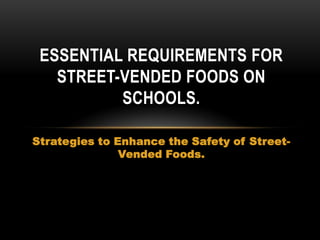Food safety on street foods ppt
- 1. ESSENTIAL REQUIREMENTS FOR STREET-VENDED FOODS ON SCHOOLS. Strategies to Enhance the Safety of StreetVended Foods.
- 2. STREET FOODS ŌĆó Are defined as foods and beverages prepared and sold by vendors in streets and other public places for immediate consumption without further processing or preparation.
- 3. BENEFITS OF STREET FOODS Street foods provide: ŌĆó A source of cheap, convenient and often nutritious food for urban and rural poor. ŌĆó A major source of income. ŌĆó A chance for self employment and the opportunity to develop business skills with low capital investments.
- 4. DISADVANTAGES ŌĆó In contrast to the potential benefits, it is also recognized that street food vendors are often poor and uneducated and lack appreciation for safe food handling. ŌĆó Street foods are perceived to be a major public health risk.
- 5. STREET FOODS MAY POSE SIGNIFICANT HEALTH PROBLEMS ŌĆó Lack of basic infrastructure and services, such as potable water supplies. ŌĆó Insufficient resources for inspection and laboratory analysis. ŌĆó General lack of knowledge about the microbiological status or precise epidemiological significance of street foods. ŌĆó Poor knowledge of street vendors in basic food safety measures. ŌĆó Inadequate public awareness of hazards posed by certain street foods.
- 6. REQUIREMENTS IN THE HYGIENIC HANDLING OF STREET FOODS.
- 7. GENERAL REQUIREMENTS ŌĆó General issues commonly addressed in codes of practices and regulations include aspects such as licensing and display of notices. Where licences are included it may be appropriate to award them conditional to the commitment of the vendor to the preparation of safe food and subject to their knowledge of safe food-handling practices.
- 9. GENERAL REQUIREMENTS ŌĆó Requirements on display of notices should also focus on food safety messages. For example, it may be a requirement that vendors selling raw or partially processed animal products for immediate consumption be required to display a sign that informs consumers of the increased public health risk associated with consuming food in such states.
- 10. RAW MATERIALS ŌĆó Food is susceptible to contamination at all stages of the food chain. Raw materials are therefore important to the safety of street-vended food because of the biological, chemical and physical hazards that may be introduced to the vending operation and which may persist through preparation and processing.
- 11. WATER AND ICE Water is a critical raw material in many street food vending operations. It may also be contaminated with biological, chemical or physical hazards. As such contaminated water will create a public health risk if it is: ŌĆó used for drinking purposes ŌĆó used for washing of food, incorporated into food as an ingredient and used in the processing of food ŌĆó used in the washing of equipment, utensils and containers.
- 12. WATER AND ICE ŌĆó Freezing does not remove chemical hazards and should not be considered a safe process for the removal of biological hazards. Consequently contaminated ice may introduce hazards to food and beverages with which it is in contact
- 13. PREPARATION AND PROCESSING ŌĆó Preparation and processing should: ŌĆó be adequate to eliminate or reduce such hazards to an acceptable level ŌĆó prevent growth of pathogens, production of toxic chemicals and the introduction of physical hazards ŌĆó ensure that foods are not recontaminated
- 14. TRANSPORTATION AND STORAGE ŌĆó The vehicle used for transport should be clean. ŌĆó Prepared foods served hot should be kept at a temperature of at least 60┬░C to prevent microbial growth. ŌĆó Prepared foods which are to be served cold and which may support the growth of pathogens should, if cooling capacity (ice of appropriate quality, refrigeration etc.) is available, be stored at less 10┬░C.
- 15. VENDING UNITS EQUIPMENTS AND UTENSILS ŌĆó Vending units should be designed and constructed so that they are easily cleaned and maintained. ŌĆó Structurally, equipment, utensils and other containers should allow easy cleaning and should not have pitted, grooved or sculpted surfaces. ŌĆó If raw meats, poultry or fish are handled, their preparation should be carried out using separate equipment and utensils to minimize cross contamination.
- 16. FOOD HANDLERS Food handlers may introduce biological hazards: ŌĆó when suffering from specified diseases; ŌĆó from organisms on the food handlersŌĆÖ skin or in their intestine and feces ŌĆó when respiratory tract organisms contaminate foods or food contact surfaces ŌĆó by cross-contamination after handling raw materials.
- 17. REQUIREMENTS AT THE POINT OF SALE ŌĆó Food should be prepared and sold in a clean, well-lit place protected from strong sun, dust, rain and wind. ŌĆó Food vendors should either sanitize eating and drinking utensils between use or use disposable utensils. ŌĆó When required, food should be wrapped in clean paper, plastic or other suitable material. ŌĆó Vendors who are patronized by high risk groups (e.g. around schools, institutions for the elderly, hospitals etc.) should be particularly vigilant in controlling food safety.
- 18. CLEAN AND SANITIZING ŌĆó Vendors should employ cleaning procedures which ensure that vending unit, equipment and utensils are properly clean.
- 19. WASTE DISPOSAL AND PEST CONTROL ŌĆó All waste should be handled and disposed of in such a manner as to avoid contamination of food and water and the environment. In particular, access to food waste by pests (insects and rodents) as well as by animals (dogs and cats) should be avoided.
- 20. Submitted by: 3F2 Collado, Dan Mark Pineda, Wanina Larice Villaruz, Jessica Faye




















